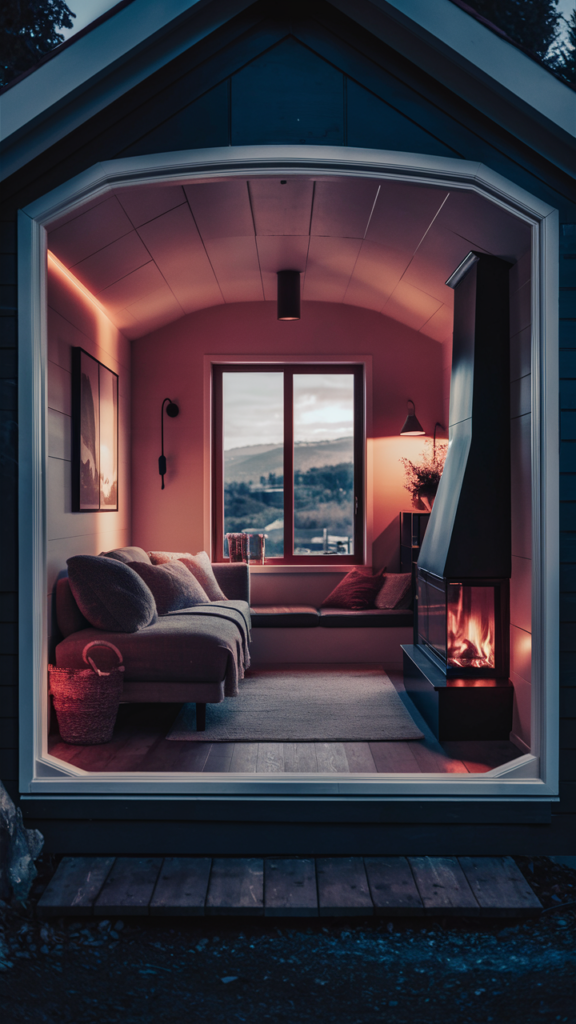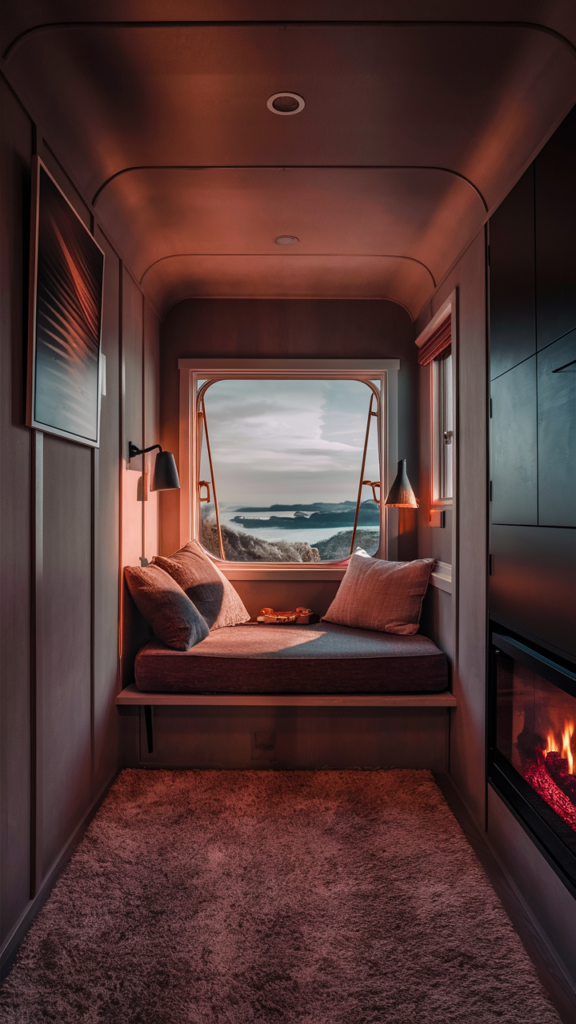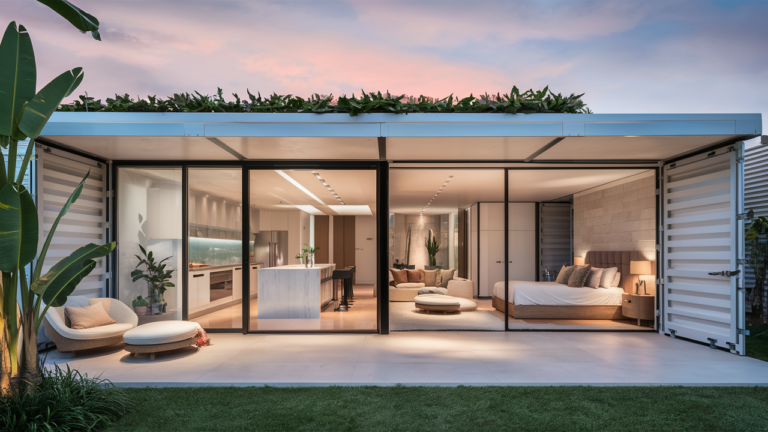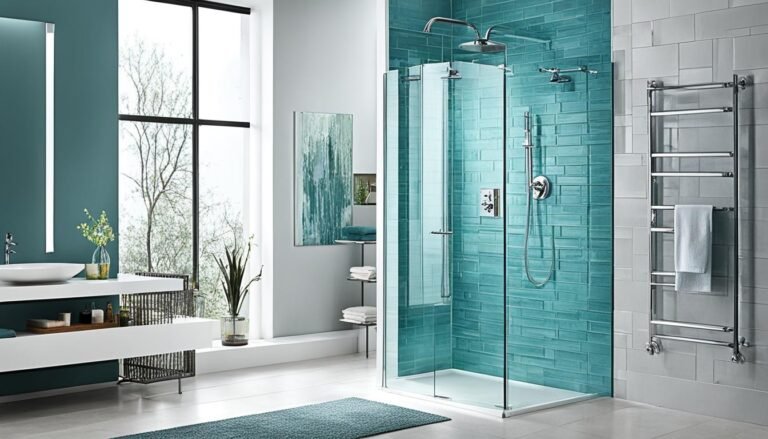
Small Home Inspiration: Cozy Living Room Ideas for Small Spaces
Have you ever thought about making a tiny living room feel like a comfy retreat? It’s possible even in a small space. Picture sitting on a cozy sofa or basking in the soft light from pale walls. There are many ways to make tiny living rooms warm and inviting!
Turning a small living room into a welcoming spot is all about the right design. Light colors can make the room seem bigger. Choose furniture that does more than one thing, like a sofa that turns into a bed. Mirrors and rugs can also help, making the room look and feel open.
Keeping things organized stops a small living room from feeling cluttered. Use shelves that hang on the wall for extra storage. Also, pick small, comfy chairs that don’t take up much room. This way, you can have a cozy space that’s always tidy.
From a lush Parisian chair to a clever storage sofa, there are so many cozy ideas. Start with what you love and let your imagination guide you. You can turn your small living room into a place that’s both beautiful and functional.
Create an Illusion of Space with Light Colors
Turn a small home into a spacious place by choosing the right colors. Light shades do wonders to open up tight spots. They add warmth and can make your living area look bigger than it is.
Why Light Colors Work
Light colors bounce natural light around, giving your space a brighter feel. This effect works with many colors, not just white. Soft tones and pastels also help a room seem more open. In small living rooms, about 60% use light colors to feel cozier. What’s more, nearly half of them pick floating furniture. This choice keeps the place from feeling cramped, especially with darker colors.
Best Shades for Small Spaces
For a small home’s living room, go for light colors that suit your style. Here are some great options:
- Whites and Off-Whites: Timeless and airy, these shades work wonders.
- Soft Pastels: Colors like mint, pink, and pale blue bring calm and space.
- Neutral Tones: Beige and light gray add a cozy touch without closing in your room.
- Light Blues and Greens: They invite nature in, adding peace and roominess.
Using these colors can make your tiny living room feel more open and friendly. Adding mirrors strategically boosts the effect. So, picking the right color theme is crucial for making a small room seem spacious. It’s at the heart of smart living solutions for compact spaces.

Opt for Multifunctional Furniture
Multifunctional furniture is a key to making small living spaces work better. With these pieces, your home doesn’t just look good. It also stays tidy and organized.
Examples of Multifunctional Furniture
Here are some great options in multifunctional furniture for you:
- Storage Ottomans: They work as seats and hidden storage. Perfect for keeping your space neat by hiding away blankets, books, or clutter.
- Sleeper Sofas: This $259.99 sofa is versatile, turning from a couch into a bed. It’s great for guests and saves space.
- Floating Desks: A Folding Table Wall Hanging Against The Wall Table, it holds up to 100kg. As a desk, it saves space and can be easily folded away.
- Murphy Beds: The Merax Twin Size Murphy Bed with Wardrobe and 3 Storage Drawers is a bed, cabinet, and storage. It’s a great space-saving solution.
- Freestanding Closet Organizers: Try the Tribesigns Double Rod Freestanding Closet Organizer. It can hold up to 500 lbs of clothes and keeps your living area tidy.

How to Choose the Right Pieces
Choosing multifunctional furniture wisely is important. Follow these tips to make your space work for you:
- Measure Your Space: Always measure your room first. This ensures your furniture fits without crowding the space.
- Prioritize Needs: Decide what you really need, be it more sleeping room, places to store things, or a spot to work. This guides you in choosing the most useful furniture.
- Look for Slim Profiles: Items with a small footprint, like slim sofas, can make your space appear larger. Look for designs with tapered legs or slender build.
- Opt for Neutral Tones: Choosing furniture in neutral colors helps it blend in. This can make your room feel more spacious and cohesive.
- Balance and Symmetry: Arrange furniture symmetrically for a pleasing look. This can include doubling up on smaller sofas rather than using a large one.
By picking the right multifunctional furniture, you can add style and smart storage to your home. It helps keep your space comfortable and organized.
Incorporating Mirrors to Expand the Space
Placing mirrors strategically in your living room can do wonders. They boost natural light and make the space appear larger. This trick works especially well in small living areas. Mirrors reflect light, making the room feel open and airy.
Put mirrors behind sources of light for a great effect. It makes your room seem brighter and more spacious. Choose big mirrors with simple frames for the best results. This way, you’ll feel like you have more room.
Try a mirror gallery wall or mirrored back shelves for a cool look. These choices reflect light and make your room feel deeper. Mirrored furniture, like tables, keeps the area from looking cluttered. It helps keep the room feeling open.
Adding vintage or modern twist mirrors can enhance your space’s look. They add unique style without taking over the room. Distinctive mirrors bring a special touch to your decor.
Using mirrored items, like lamps or trays, gives your room a classy feel. They can make your space look more modern. Either a big mirror or lots of small ones, mirrors add style and function to small living rooms.
Mirrors create a pathway that connects your living room to other parts of your home. Placing one across from a window brings the outside in. This makes your room feel bigger and peaceful.
Using Rugs to Define Areas
Area rugs are key in a living room, taking care to define spaces and set visual boundaries. The right choice can boost the decor and add warmth and texture. They help tie the room together.
Here are five tips for laying out your rug:
- Ensure that the rug serves as an anchor, balancing and harmonizing elements within the room. This can be achieved by centering the rug on major architectural features like a fireplace, large windows, or a main focal wall.
- To maintain balance, place furniture either completely on the rug or with just the front legs on it. This rule of thumb helps create a cohesive living room layout.
- Avoid using rugs that are too small and centered under a coffee table. Instead, a well-sized rug should fit comfortably under all main furniture groupings.
- Playing with rug angles can enhance the room’s aesthetic and provide visual cohesion. Consider using angles to create dynamic and interesting living spaces.
- Reserve small rugs for specific areas like inside doors, kitchen sinks, or bathmats. Avoid scattering them randomly across the floor as they don’t effectively define living areas.

Patterns can make a small living room look stylish without overwhelming it. Matching colors in different shades ties everything together. For instance, a room in blue/gray can look great with a teal blue rug.
Choose larger rugs with patterns for more furniture layout options. They keep the room stylish while being functional. A rug can also link a work space to the living area, smoothing the flow between areas.
When layering rugs, make sure they match in size and style. Good coordination keeps the look calm. And leaving space between patterns makes it inviting yet balanced.
Rug Sizes to Consider
The favorite rug sizes for living rooms are 8’x10′ and 9’x12′. Rooms that are 11’x13′ or smaller should use a 6’x9′ rug. For mid-sized living rooms, go for 8’x10′. Larger spaces need bigger rugs, like 9’x12′, 10’x14′, or 11’x15′.
Follow these tips to make the most of your rugs. They will help define living areas and make your living room look and function better.
Maximize Vertical Storage with Floating Shelves
Urban homes often lack space, so floating shelves are essential. They utilize wall space well. Furthermore, they look great and help in organizing your living room.
Types of Floating Shelves
There are many types of floating shelves. Each type caters to different styles and needs:
- Wooden Floating Shelves: They give off a cozy, natural vibe, especially in rustic settings.
- Glass Floating Shelves: These are perfect for modern rooms. They look clean and simple.
- Marble-and-Brass Floating Shelves: For a dash of elegance in places like bars or kitchens.
- Wall-Length Shelves: Excellent for long walls. They offer a neat, spacious feel, as seen in Urbanology Designs in Dallas, Texas.
- Mini Floating Shelves: Great for tiny spots. They work well in guest rooms, too – a tip from Four Brothers Design + Build.
Installation Tips
Putting up floating shelves in your living room is easy. Just remember these pointers:
- Determine Placement: Use apps like DecorMatters to see where your shelves fit best. This ensures they add both style and function.
- Secure Properly: Mount shelves on studs or use strong wall anchors. They must hold the weight safely.
- Height Adjustment: Variation in shelf height adds interest. Over-the-door shelves are another smart choice for extra storage.
- Consider Lighting: Wall lights make your shelves stand out. They add to a tidy, well-arranged look.
Choosing and placing floating shelves the right way transforms your living room. It combines elegance with usefulness.
Include Cozy Seating Options
Picking the right seating options is key in a tiny living room. It’s about comfort and size. This helps avoid making the space too full, keeping it both useful and welcoming.
Best Small-Scale Armchairs
In a small living room, comfy seating is important. Choose small armchairs like those from West Elm or Article. These should be cozy, made from fabrics like velvet. Prudence Bailey of Prudence Home & Design says it makes your place feel warm. Also, pick armchairs with slim legs. This makes the room look bigger.

Sofa Choices for Small Spaces
Pick the right sofa size and style for coziness. Compact sofas or loveseats, from places like IKEA or Joybird, are perfect. They give enough seats without taking up too much space.
Cynthia Masters of Panageries suggests soft fabrics for a cozy feel. Think about charcoal grey velvet or wool with floral patterns. These add comfort and look nice. Also, look for storage sofas. They help keep your space neat.

Decorating with a Neutral Palette
Choosing a neutral palette for your home can turn a small space into a calming retreat. Neutral colors are common in many Scandinavian homes. They make rooms look bigger and brighter. You can easily change the look by adding different accent colors to a neutral backdrop.
One big benefit of using neutral colors is they work in many styles. The English country look, for example, uses neutral tones and adds warmth with wooden beams and linen. Mixing in different textures is key. It creates interest in a space filled with neutral colors.
Cozy living rooms often use subtle neutral shades. A touch of pale green can make a neutral room feel alive. Plants and flowers also bring life and color into these spaces. This creates a calm and welcoming room.
Adding a few modern elements can work well with neutral tones. Sleek furniture keeps the room looking fresh. For fall, consider adding warm leather and fur items. These will bring a cozy, rustic vibe to your space.
To keep a neutral room from feeling dull, use pops of color. This could be through pillows, art, or flowers. This lets you keep up with trends and seasons easily. Looking for vintage or vintage-style decor can also enhance your neutral room.
With a neutral palette, your living room can be a cozy and stylish place. Whether you like rustic or modern, neutrals offer a blank canvas for any design. They let you showcase your favorite decor and keep your space inviting.

Smart Storage Solutions for Small Living Rooms
It’s tough to make small living rooms work, but smart storage can do wonders. About 78% of small living rooms have to be multipurpose. Full-height shelves can be your best friend here. They let you use the walls for storage, freeing up the floor. And you keep things neat and tidy, too.
Bespoke cabinetry, made just for your space, offers 30 to 40 percent more storage. These custom pieces fit perfectly, not wasting any space. They’re great for places with odd shapes, like rooms with slanted ceilings. Philipp Nagel points out that custom furniture fits these unique spaces well.
Making storage symmetrical can change how your room looks and feels. Many folks, around 42%, choose custom shelving that stretches from one end to the other. This kind of storage keeps things balanced. Modular shelves are also becoming more popular. They let you mix and match to fit your needs, all while saving space.
Furniture that does more than one job is key in small rooms. Ottomans with storage or benches that open up give you extra space to stash things. Built-in cabinets are a hit for 30% of people wanting tidy spaces. Adding shelves is a popular choice, with 50% liking them. No matter the approach, good storage makes a small living room both practical and pretty.










